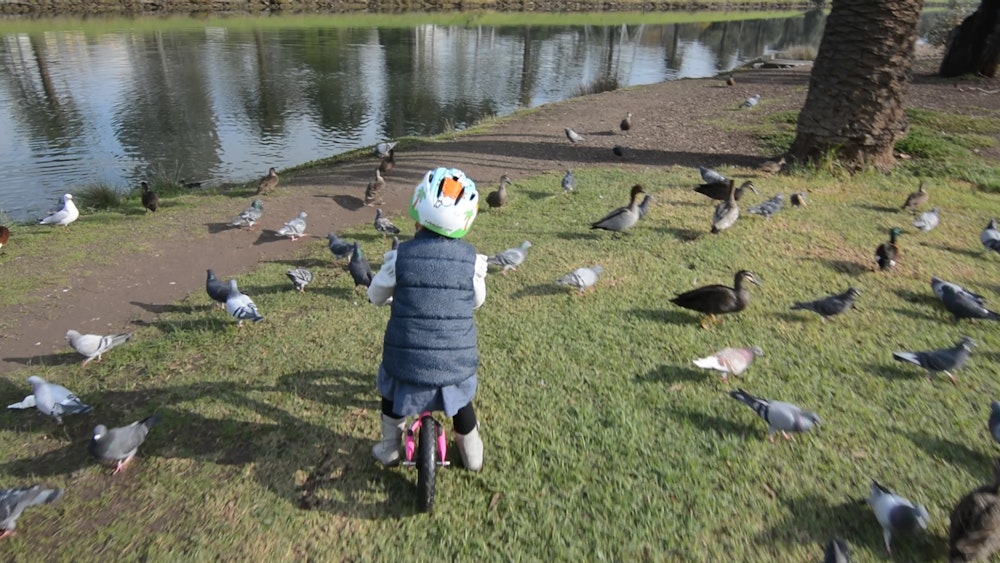Balance bikes are also known as ‘walking’ or ‘running’ bikes as they have no pedals and rely on the child to push themselves along with their feet. Some balance bikes are designed to suit children from as young as 18 months, although two years is a more common starting age.
The key skill of riding any kind of bike is balance. Balancing is a skill that is universal regardless of whether you intend on riding a road bike, mountain bike or even a motorbike! That’s why balance bikes are a good option for children, they are not only fun, they teach fine motor skills and good habits right from the get go.
On a standard pedal bike with training wheels, children are encouraged to pedal first and balance second. This can make the progression difficult when the training wheels are removed and the focus becomes balance first, pedaling second. When it is time for a child to move to a pedal bike, then those comfortable on balance bikes need only to learn how to pedal, a much easy progression.
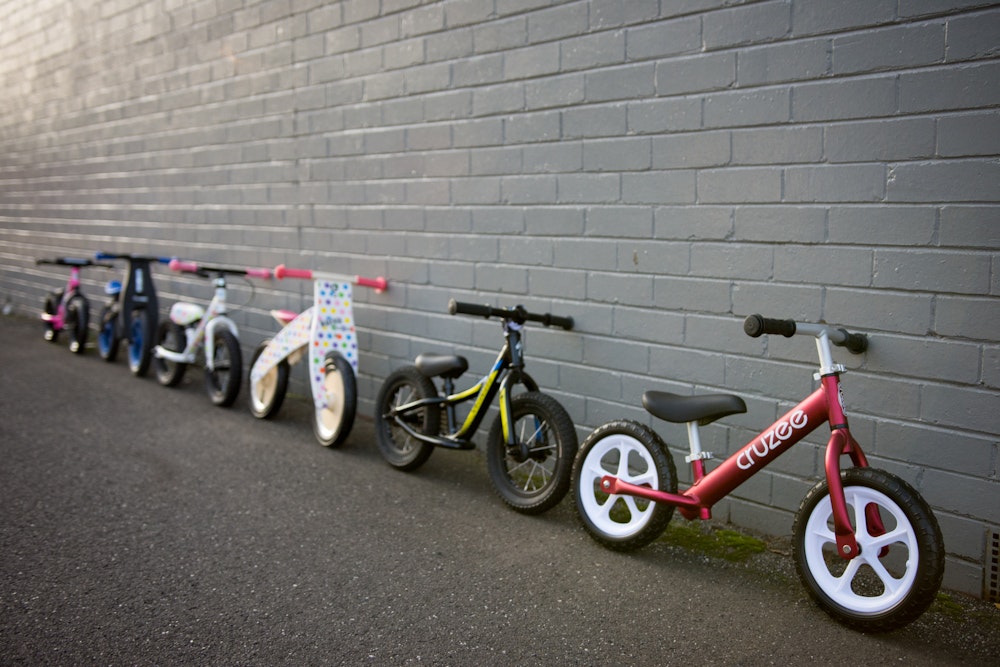
Benefits of a balance bike
Safety: In the early stages of learning to ride the balance bike if the child is unsure or lacking confidence, they can simply put their feet down when they need to. The child should be able to comfortably stand over the bike, allowing them to walk along standing over the bike to further improve their confidence before trying to ride it properly.
Confidence: Confidence is everything for children and having the ability to learn at their own pace is crucial. Riding a balance bike encourages children to master the basics first and progressively develop more advanced skills associated with riding a bike.
Coordination: Riding a balance bike will improve a child’s coordination and fine motor skills which will carry over into other facets of life. Riding will help their depth perception, spatial awareness and overall physical abilities including strength, flexibility and mobility.
Basic Traffic Rules: Riding outside will teach children basic traffic rules like stopping for lights, looking for traffic and crossing the road. A mastery of these rules is essential before children can be left on their own to explore the world.
Health: With the abundance of electronic devices at our disposal these days it’s great for kids to seek out as many active pursuits as possible. Getting out for a daily ride on the balance bike is a great way to keep young children active, and as they see their progression they will want to ride even more.
Fitness: Being active will also improve their fitness. Obesity rates are rising at an alarming rate, anything we can do to increase activity and teach children healthy lessons is going to benefit them in the long run. Getting children into a healthy, active routine is also important to build lifelong fitness habits. If you start them young, physical activity will seem like a normal everyday thing, and not a chore.
Outdoor activity: Getting kids outside and active is crucial. Getting them away from computers, tablets and TV screens is a great way to break up their day and keep them active. Being outside will also invigorate them to keep going for the rest of the day.
React to stimulus: Riding outside will encourage children to react to their environment and learn to deal with outside factors like temperature, wind, possibly rain and varying terrain. Getting used to these factors early will make the transition to riding a pedal bike on their own much easier.
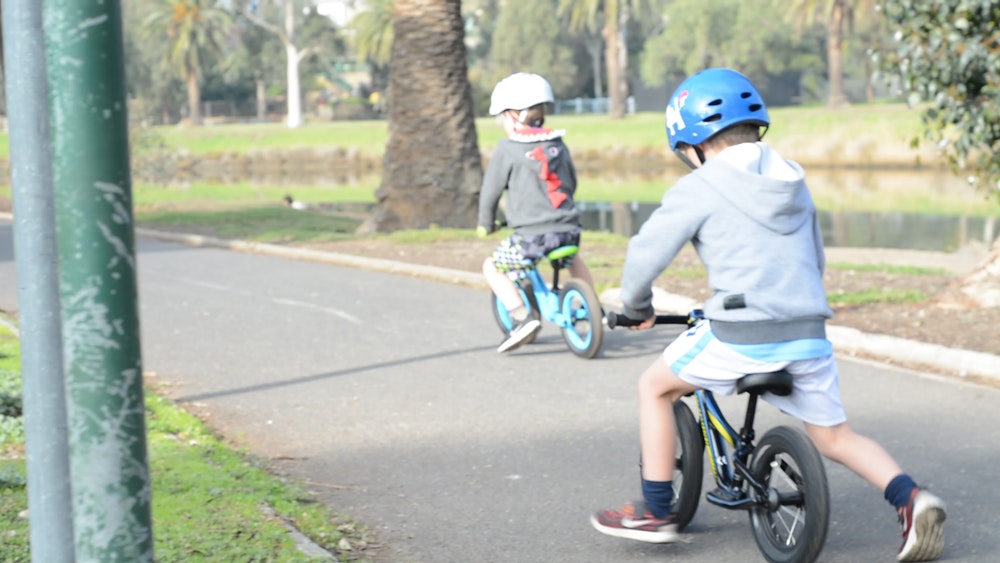
How do you know when your child is ready for a balance bike?
A child needs to be able to walk confidently to use a balance bike. As well as being able to balance they need to be able to push themselves along, obviously not possible if they can't walk.
A child needs to be able to comfortably stand over the balance bike and place their feet on the ground. This will reassure the child they are in control and provide stability if they need to stop or put their feet down.
Don’t force a child into riding a balance bike. Children need to enjoy the experience and have a positive association in order to want to ride it and learn how to do it. If you force or pressure a child into riding a bike they could end up resenting the bike and you.
Choosing the right balance bike
Choosing the right balance bike might seem simple in comparison to a pedal bike; there are less moving components, they appear easy to operate, they are small, and they cost far less than a full sized pedal bike. But don’t be fooled, there are many things to consider to ensure you choose the right bike.
Below are the key elements you need to consider when choosing the right balance bike.
Size
Size is the number one thing to consider when buying a balance bike. Don’t think of a balance bike the same way as a pair of shoes, the bike needs to fit the child right now, not in 6 months time.
Getting a bike that is too big or too small will make the child feel uncomfortable and lead to a negative experience. If they aren’t happy on the bike they won’t want to get on it.
The most common size for balance bikes is either 12” or 14” which relates to the size of the tyres. Although tyre size is a useful measurement, it is not indicative of the frame size or seat height of the bike. As well as looking at the bikes tyre size, be aware of the minimum and maximum seat height.
Consider a few of the following questions when figuring out if the size of the bike is right.
Can the child easily stand over the bike?
Can the child walk the bike while standing over it?
Can the seat be adjusted as the child grows?
Can the child easily reach the handlebars when sitting on the seat?
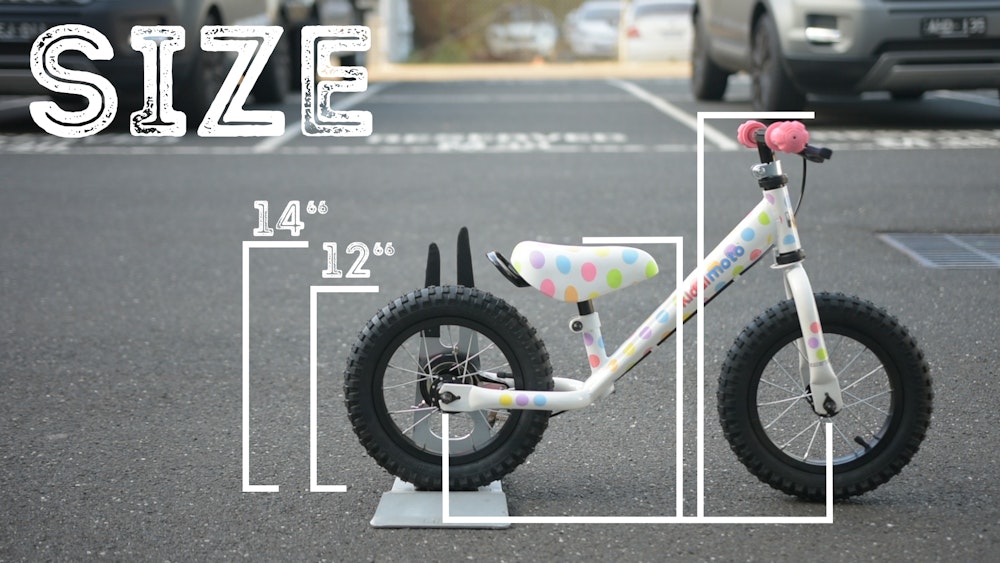
Seat height
Seat height can vary a large amount and isn't dependent upon the size of the bike or tyres.
Seat height of balance bikes will typically begin at 10" and can go right up to adult sized balance bikes in excess of 40”. The best way to know if a child will fit the bike is to get them to stand over it. Failing that, measure their inseam and allow 1.5” - 2" leeway to the seat.
For example: if a child's inseam is 16", the seat height for their balance bike cannot be over 14". Be sure to measure a child’s inseam without shoes on.
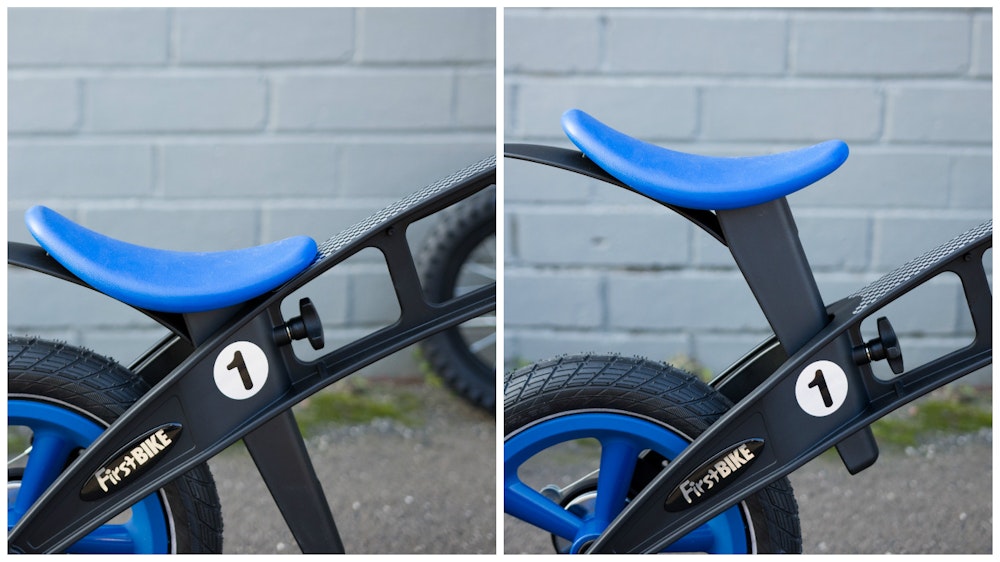
Tyres
Tyres come in many different forms; solid foam, pneumatic (simply a tyre inflated with air), honeycomb rubber, solid rubber and hard plastic.
The two main types of balance bike tyres are pneumatic and foam.
Pneumatic – Standard air inflated tyre
These tyres are most common thanks to the all-round benefits they provide. Pneumatic tyres provide a cushioned ride and good grip. They come in multiple tread patterns which are typically either knobby tyres, similar to mountain bike tyres, or a standard tread pattern, which is similar to road bike tyres.
Depending on the area you live in and the type of terrain the child will be riding, the tread pattern can make a big difference. Choose the relevant tread type to your area to provide the best possible platform for the child to enjoy their riding.
As with mountain bike and road bike tyres, pneumatic tyres are prone to flats. If children run over a piece of glass or run into a curb at speed, they can cause a pinch flat or puncture.
To avoid having to change the tyre, sealant can be placed into the tyre which will quickly cover any cuts or holes that occur while riding. Your local bike shop can provide you with some sealant or a puncture repair kit. Ensuring the tyres are kept inflated to the recommended pressure should generally be sufficient prevention from flats.
Foam tyres
These tyres are commonly used thanks to their lightweight, durability, low profile, low maintenance and low cost. They don't provide the cushioning or grip that standard tyres do but they are cheap and there's nothing to puncture. Additionally, these foam tyres sit with a lower profile and so are sometimes used to create lower and smaller bikes.
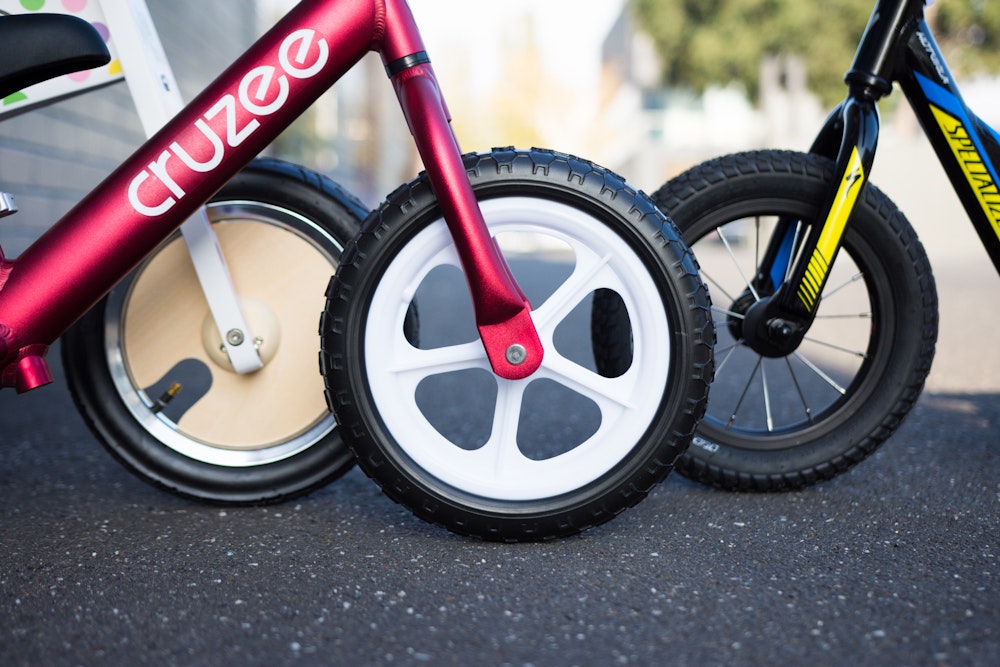
Material
The material used for balance bikes can vary according to price and will affect the durability, weight and look of the bike.
Here are the most common materials used for balance bikes.
Steel
Steel balance bikes have a major advantage over other materials: durability. There are not many more ‘kid-proof’ materials that will stand up to the rigors toddlers and young children will put their belongings through.
This durability does come at a cost. Steel balance bikes are going to be heavier than some other materials and generally more expensive. The extra weight of the bike may be an issue for some smaller children. Steel is also subject to rust if left out or ridden in all weather conditions.
Aluminum
Aluminum is a material commonly used in full-size adult bikes thanks to its lightweight and performance characteristics. Aluminum balance bikes will be lightweight, durable and rust-proof, but can be more expensive than other materials.
Plastic
Plastic is a material commonly used on smaller and cheaper balance bikes. Plastic is typically not as strong as other materials but is lightweight, potentially making usage of the bike easier than heavier materials.
A key exception to this is seen with the 'FirstBike' out of Germany which uses an incredibly strong glass reinforced plastic for high strength, durability and lightweight. Of course, such materials don't come cheaply.
Wood
Wooden balance bikes are making a resurgence thanks to their stylish appearance, classic feel and sometimes recyclable. Wooden bikes provide a good option at an affordable price, striking a balance between cost, weight and durability.
The concern with choosing wood is it will most likely deteriorate quickly if it is left outside in the elements for long periods of time and they typically allow for limited seat height adjustment.
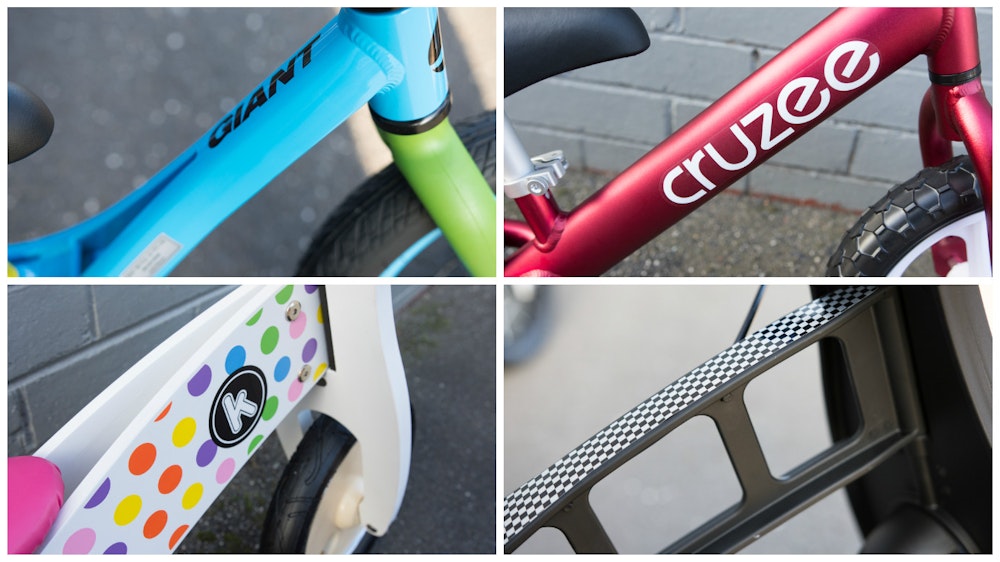
Weight
Be mindful of how much the balance bike weighs. The heavier the bike is, the harder it is going to be for a child to maneuver. The harder it is, the less likely a child is going to want to do it.
The weight of the bike will depend largely on what material it is made out of and the type of tyres. As a rough guide, aim for a bike that weighs no more than 25% of the child.
An obvious yet crucial factor to consider is the maximum weight limit of the balance bike, it is unsafe to ride if the child exceeds the recommended safe weight limit.
It's also worth considering the weight of the bike from the parent's point of view. Anyone with kids will tell you about the short attention span and potential for wild mood swings. There’s a high likelihood, thanks to the fickle nature of toddlers attitudes, you may end up carrying the bike and your child home from a ride.
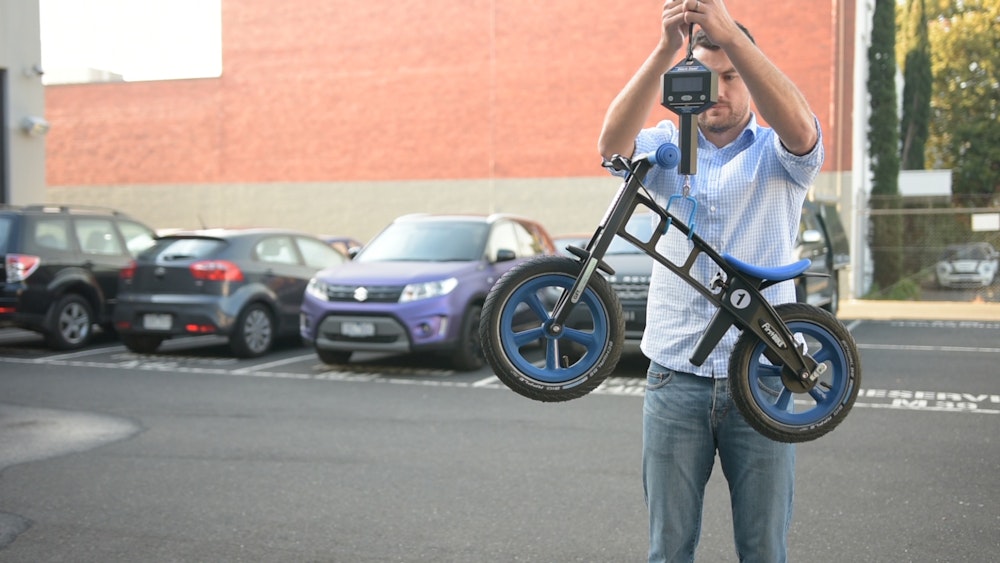
Brakes
Children will most likely stop by using their feet, either by simply putting them down and standing up or if they are going fast enough, putting them on the ground and gradually slowing themselves down.
Some balance bike come with a secondary brake operated by hand. This can be a key learning consideration as it will get the child used to using the hand brake to slow down rather than their feet.
When the child is prepared to do this will vary depending on their physical ability, confidence and strength. Around three-four years is a good guide.
Hand operated brakes on balance bikes are designed to fit the hand of a child and require minimal force to work. Before buying a balance bike with a hand operated brake, ensure it is a ‘short-reach’ lever specifically designed for small hands.
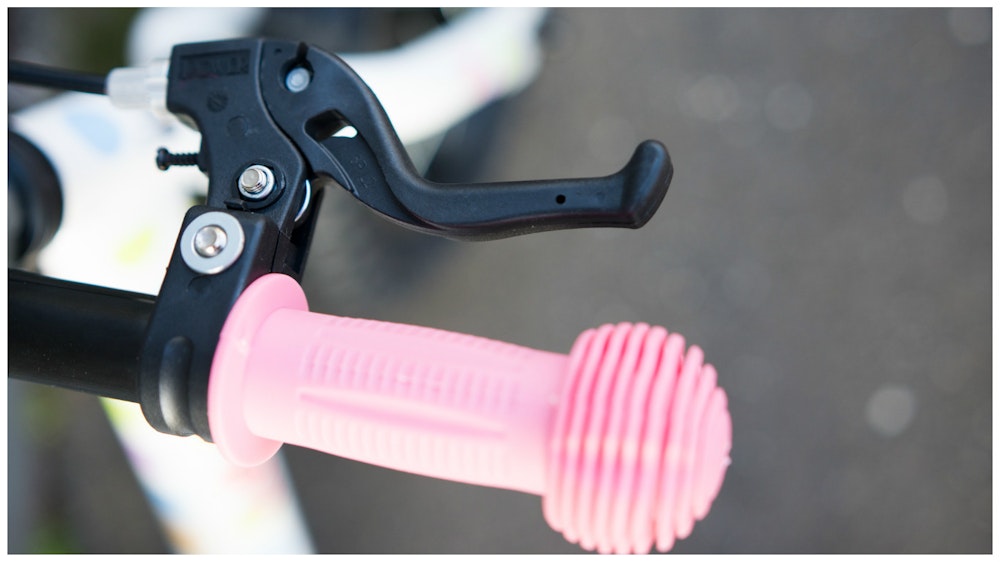
Turning limiters
As the name suggests, turning limiters reduce the amount the handlebars can turn. The theory behind the design is to provide a safer platform for children to steer the balance bike, preventing them from turning the bike sharply.
The child will still be able to steer and easily move the front wheel, but they won’t be able to perform a complete revolution of the front wheel which could lead to a crash or trip over the handlebars. Additionally, it'll prevent the child getting trapped between the bike's frame and handlebar.
The inclusion of turning limiters has positives and negatives. Those against the use suggesting it is akin to having training wheels for your handlebars and will delay the child’s progression to riding a full sized bike, or lead to problems when the limiters are removed.
If you are unsure whether turning limiters should feature on a balance bike, it is possible to get removable and flexible options, allowing you to adjust and remove as you see fit.
Footrests
Footrests are not a common feature on balance bikes nor an essential component. As the name suggests, they are a platform for children to rest their feet on while the bike is in motion.
Footrests are best considered for children that are confident on the balance bike and considered strong and physically capable of riding the bike without assistance. The only time footrests will be useful is for long downhill sections or if the child can produce enough speed to coast for long periods of time. Also if the child will regularly get a push for long periods of time.
It is essential when considering buying a balance bike with footrests that they don’t hinder the movement of the child or have the potential to cause a crash or injury. Look for footrests with a non-slip surface to provide sure-footing.
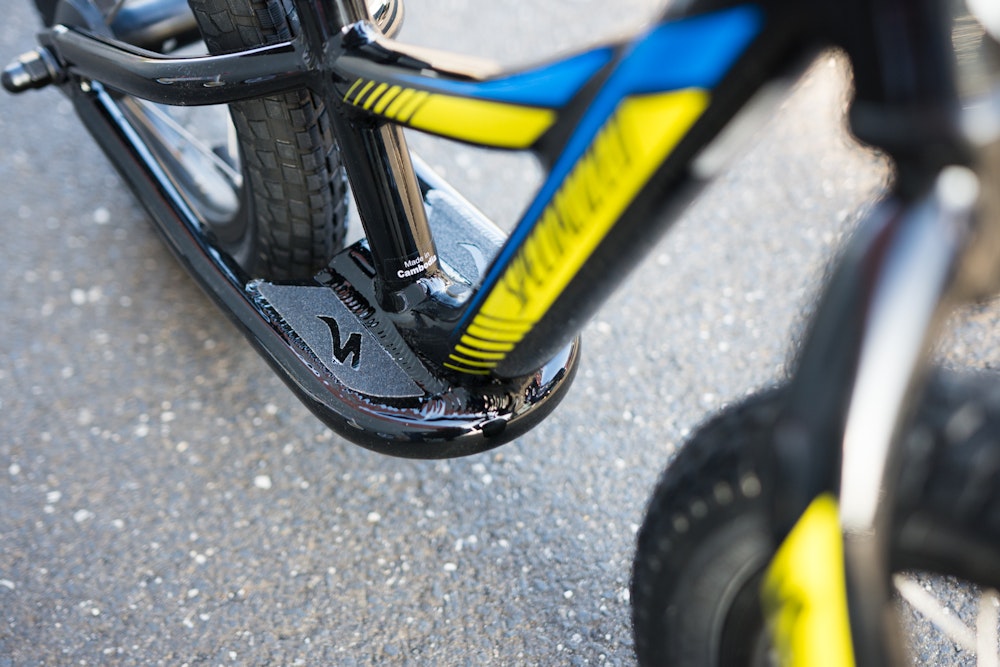
Grips
After getting the right size, the grips and the seat are the two most important points to consider. They are the two ‘touch points’ of the bike and will influence how the child handles and controls the bike.
Make sure the grips and not too thick and can easily be held onto. To provide extra protection for little hands, look for grips that have large bulges on the outside. These large bulges will provide protection for children if they scrape their handlebars against walls, bushes or other sharp objects.
They will also prevent a child’s hand from hitting the ground if they do fall off the bike or slipping off the side of the handlebars.
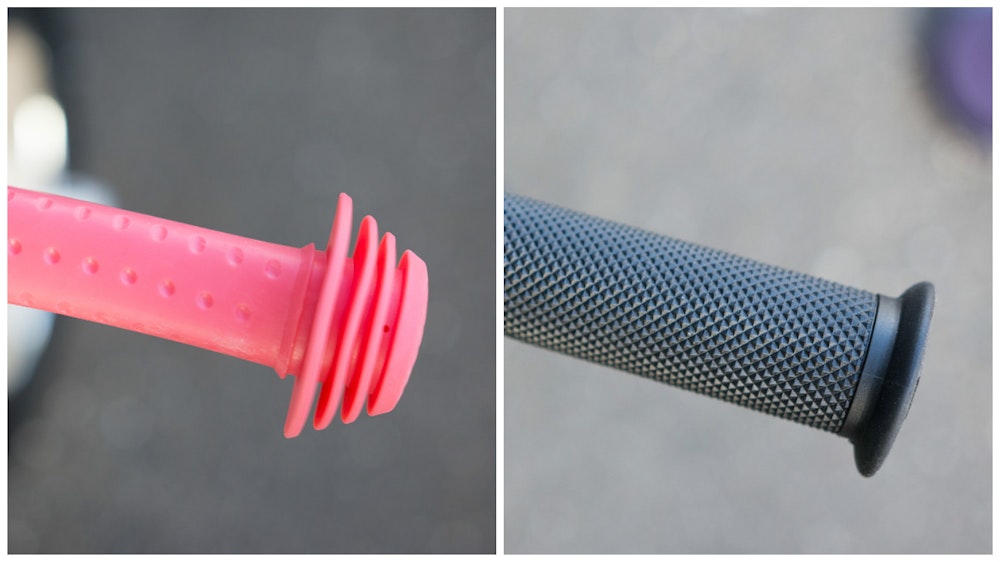
Bolts
Exposed, covered, rounded and recessed are all varying ways bolts present on balance bikes.
Exposed bolts have the potential to cause injury if a child was to fall or brush up against them, and can also interfere with the walking / running action required to move. Covered and rounded bolts provide some protection from falls and injury but can still interfere with powering the bike.
Recessed bolts are the best option as they are hidden, protecting children from any potential damage and interference with moving.
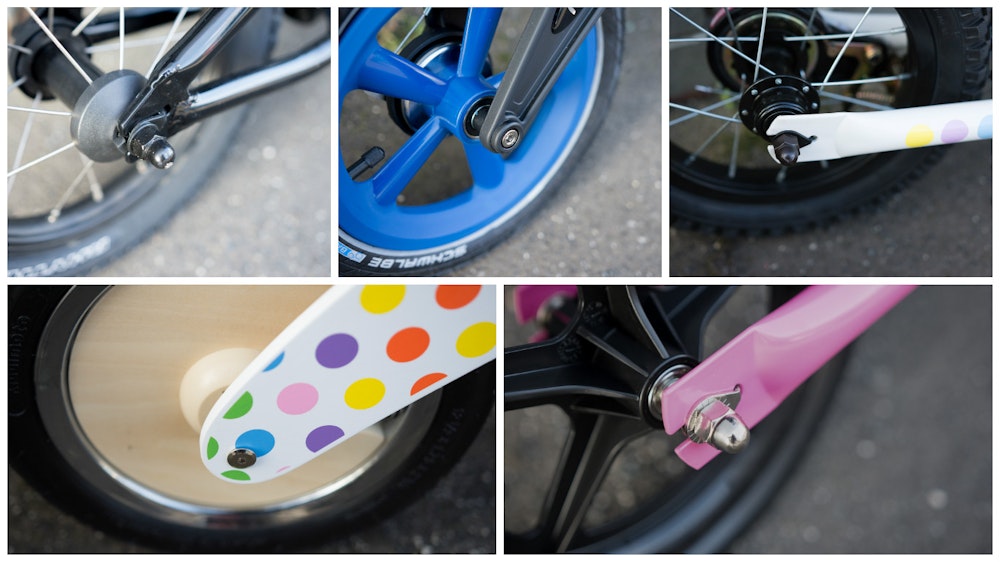
Warranty
As with any new purchase, be sure to check the warranty. Check what it covers, for how long and what you have to do to replace it if required.
Most bikes will have a lifetime warranty on the frame and manufacturers warranty on parts but check before your purchase as each bike will be different.
Depending on how many children will be using the bike, warranty may be very important. The balance bike you buy today could end up going through half a dozen kids and possibly even a couple of generations.
Price
Price of balance bikes will depend on brand, frame material, tyres, size and parts.
Spending more money doesn’t always lead to a better product so be sure to follow the above guidelines and buy a bike that fits, suits the local terrain, is lightweight and one that your child loves.
Looks
As well as meeting all of the practical guidelines when buying a bike, a child needs to fall in love with it and want to ride it.
Look for a bike that speaks to the child’s interests and gets them excited. Choose one in their favourite colour, features their favourite cartoon character, maybe go for one that looks like mum's or dad's, or maybe pick the one with racing stripes? Whatever balance bike option gets your child excited about riding is a winner.
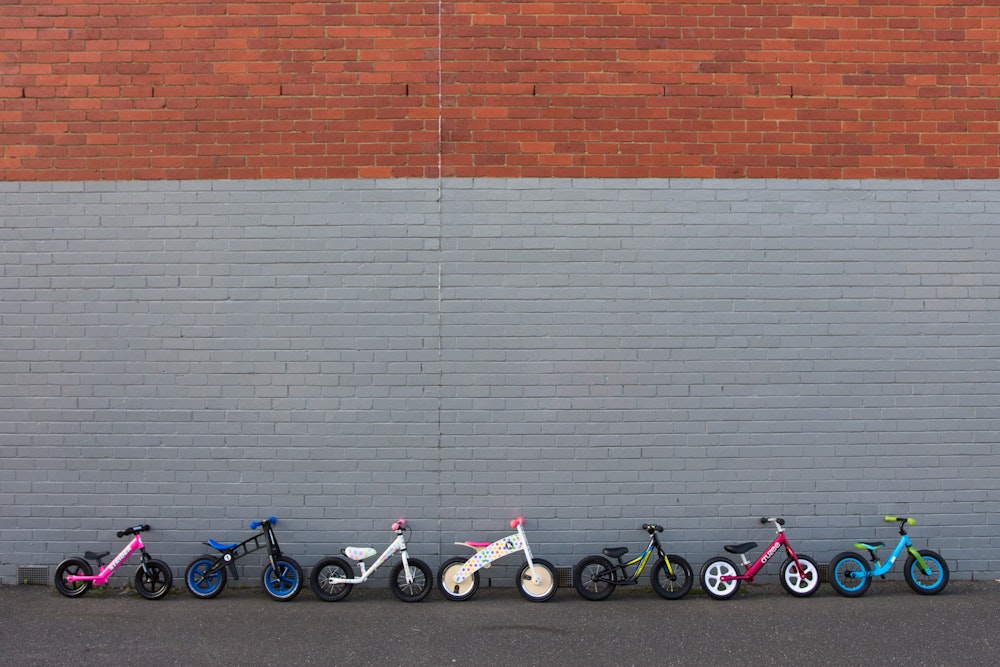
Maintenance
There are some basic things you can do to improve the function and longevity of a balance bike (and all bikes for that matter).
Tyres: Ensure tyres are pumped up to their specified pressure and any dirt or grit removed. If you don’t inflate the tyres they will be more prone to pinch flats and adversely affect the handling of the bike making things unnecessarily hard for children.
Check the bearings: Check the bearings of anything that moves; wheels, handlebars, the seat and brakes. Lubricate the bearings regularly to prevent them rusting or squeaking.
Clean and dry: Make sure the bike is always clean and dry. As mentioned above, if your bike is made from steel or wood, it can be prone to rust or degradation. If possible, keep the bike indoors at all times or at least out of the elements.
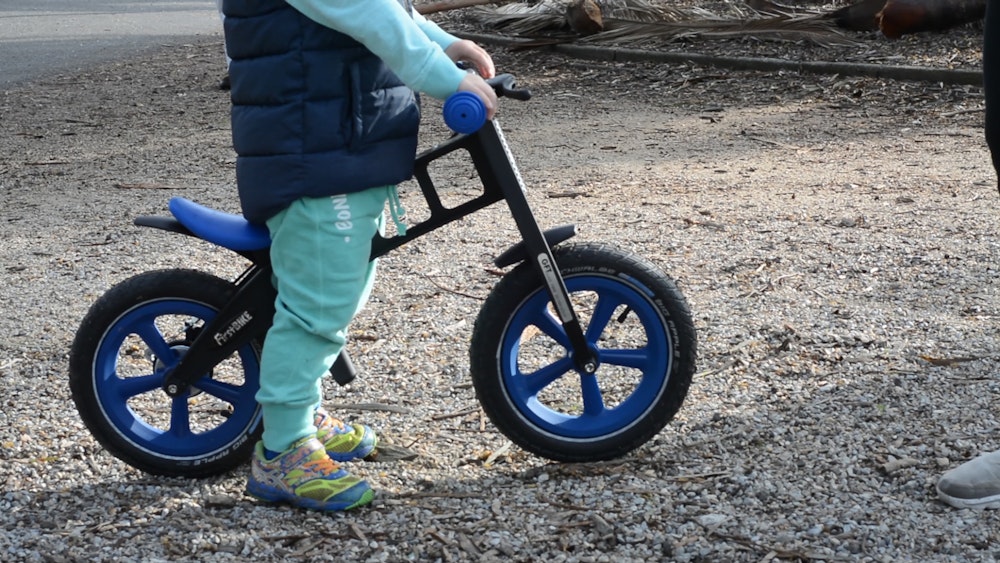
Essential accessories
Once you have purchased the perfect balance bike, it's time to think about the essential accessories to accompany it.
Helmet
Having a properly sized and fitted helmet is the most obvious and perhaps the most important. Helmets are mandatory in Australia for any age, so your child will have to wear a helmet regardless.
Wearing a helmet will develop good habits for later in life when they have grown up and are riding out on their own.
Knee and elbow pads
Knee and elbow pads are not compulsory but could speed up a child’s development on the balance bike.
Having the extra security of padding may make the child more willing to take small risks and expedite their development. Risks they may have been too afraid to take had they not been wearing them. Using elbow and knee pads while your child is in the early stages of using the balance bike can develop their skills, confidence and coordination.
As soon as they feel comfortable and their skills are good enough, it's time to take the pads off.
Helpful tips for using a balance bike
Slow and steady wins the race: When trying to teach children how to ride a balance bike take it slow and steady. Provide a safe environment, free from obstacles and hazards that's quiet and allows for plenty of time practicing.
Back on the horse: Falls are inevitable, but the quicker children can get back on their bike and restore their confidence the better. Encourage them to get straight back up and on the (metaphorical) horse.
A gentle decline is best: Pushing the bike and trying to balance can be too much too soon for some kids. If possible find a very gentle decline and let children roll down with their feet in the air so all they have to focus on is balance. A driveway is a great option; the decline will be slight, it is short so children can’t build up too much speed, and the surroundings will be familiar adding to their confidence.
Be their cheer squad: Encourage children as much as possible and praise small achievements.
Be involved: Learning to ride a bike is one of those life goals we remember for the rest of our lives so make sure you are a part of it. It can be a great bonding experience and a moment in time you can share forever.
